Medical alert bracelets are designed to be worn if you have important or unusual medical conditions or allergies that could affect the medical treatment you get if you are incapacitated, unconscious, or otherwise unable to communicate with medical personnel.
There’s a wide range of medical conditions that doctors often recommend wearing an alert bracelet for, including type one diabetes, certain allergies, and having a pacemaker to name just a few.
Medical alert bracelets aren’t just for medical emergencies, either. They’re often recommended for people who have memory issues or degenerative cognitive conditions like Alzheimer’s disease, in case they get lost and disoriented—a passerby or Good Samaritan can use the bracelet to figure out who to call to help your loved one get back to where they belong.
If you or someone you love needs a medical alert bracelet, here are the ten top manufacturers of medical alert bracelets.
Research
Rankings
1. Road iD

Road iD specializes in making medical alert bracelets for runners, hikers, cyclists, and other active individuals. A standard all-metal medical alert bracelet is usually too cumbersome if you are out for a run—it bounces around and irritates your skin when you sweat.
Road iD makes sweatproof and waterproof bracelets as well as shoe tags that are lightweight and very easy to use. They aren’t as stylish or elegant as some of the more jewelry-inspired medical alert bracelets, but Road iD is impossible to beat when it comes to usability for people with an active lifestyle, making it our top pick.
2. Medic Alert
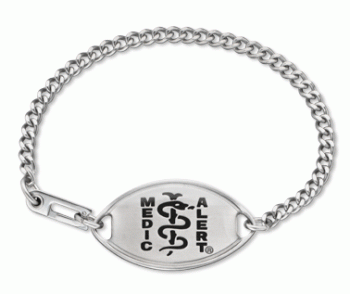
Click here for more information
Medic Alert makes classically-styled low-profile medical alert bracelets. Their best products have small, round medical alert tags on slender chains.
It’s a pragmatic and durable design, as the bracelet is made of all-stainless steel, so it won’t tarnish or scratch. If you need something understated and easy to wear, this should be your choice.
3. American Medical ID
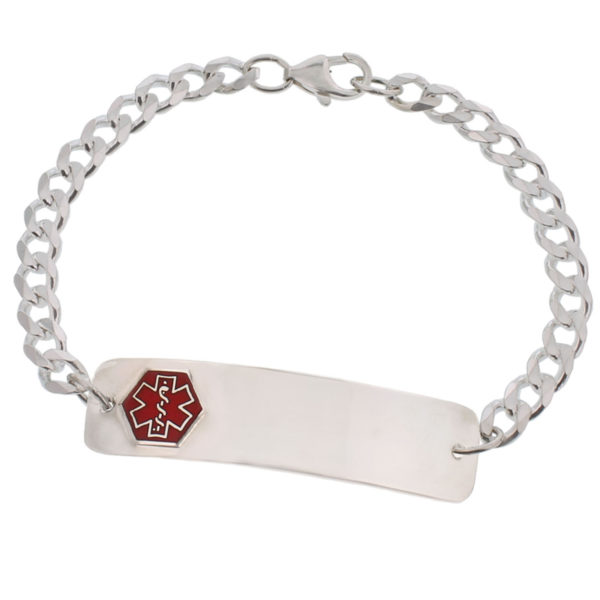
Click here for more information
American Medical ID makes medical alert bracelets in the classic style you’re probably familiar with. Their bracelets are mostly silver wristbands with a slim profile that still leaves enough room for a few lines of engravings.
There are a lot of options for sizing, which makes American Medical ID a great choice if you’ve got unusually small or large wrists.
The base medal is silver, with an overlay of rhodium to prevent tarnishing and scratching, so this medical alert bracelet will last for quite a while.
4. Lauren’s Hope
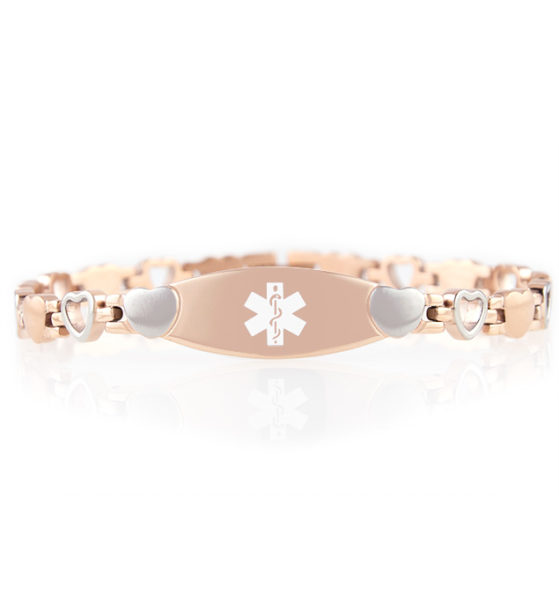
Click here for more information
Lauren’s Hope makes a wide range of medical alert bracelets, but their best products are those that are specially tailored for women.
There are options in rose gold, silver, and real gold. Many Lauren’s Hope medical alert bracelets are designed to resist tarnishing from exposure to harsh chemicals, like those found in swimming pools and spas.
If you want bracelet options that are trendier, flashier, and stylish, Lauren’s Hope is the way to go.
5. Elegant Medical Alert
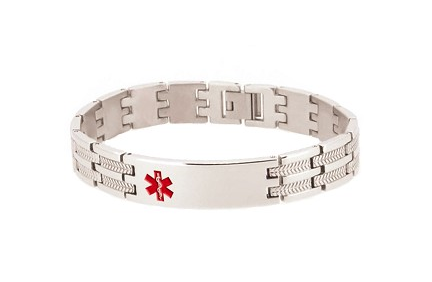
Click here for more information
Elegant Medical Alert makes medical alert bracelets chiefly out of durable and corrosion-resistant metals like stainless steel. Their best medical alert bracelets are made of thick, heavy metal links and are easy to spot.
The more rugged and durable look isn’t for everyone, but if you are worried that smaller and more delicately made medical alert bracelets won’t hold up with your active lifestyle, Elegant Medical Alert Bracelets are a good option.
6. N-Style ID
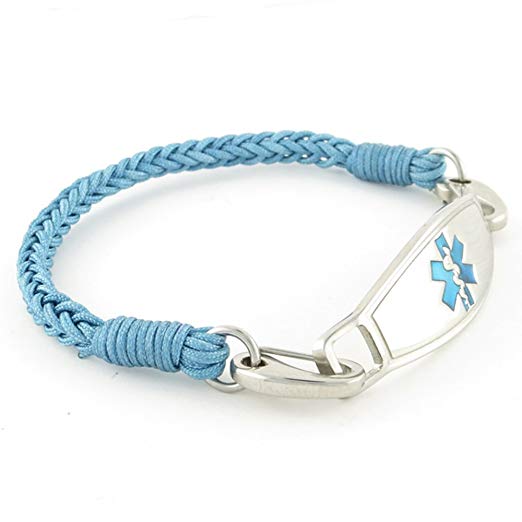
N-Style ID is the medical alert bracelet with the broadest variety in the styles of medical alert bracelets that it offers.
This company makes everything from nylon paracord bracelets to rose gold metal bracelets, all of which have easily recognizable medical alert symbols.
While the materials and design aren’t quite as durable as some of the other medical alert manufacturers, the options when it comes to style are unmatched, so if you are picky about fashion or if you want something a little out of the ordinary, N-Style ID is the way to go.
7. StickyJ Medical
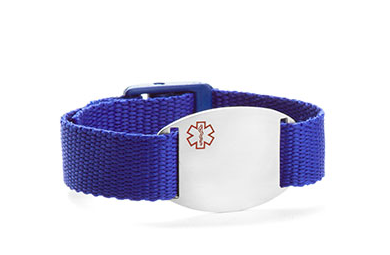
Click here for more information
StickyJ Medical uses a broader variety of materials in their most popular medical alert bracelets. It’s a good source for “disposable” medical alert bracelets that you can travel with without worrying about losing, or to bring along as a spare.
With inexpensive but durable materials like silicon and nylon bands, StickyJ Medical Alert Bracelets are good options for people who don’t like heavier and more understated metal medical alert bracelets.
8. Universal Medical Data Elite USB
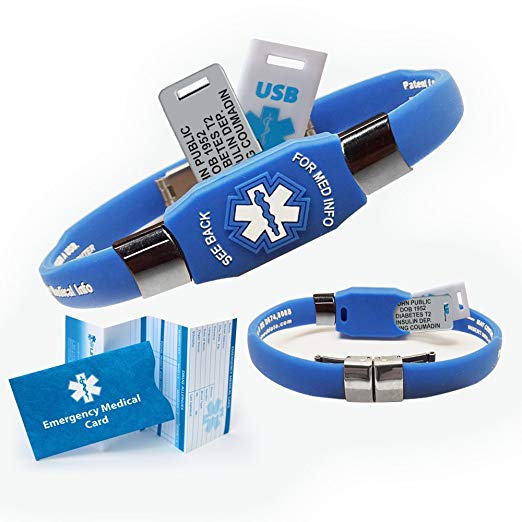
Among the various makers of medical alert bracelets with USB capabilities, Universal Medical Data makes the best.
The utility of any electronic medical alert bracelet is sometimes questionable, because first responders often won’t have the time or resources to open up detailed information on a USB drive.
Universal Medical Data gets around this by providing an easy to cary medical alert card that’s made of waterproof and rip-resistant Tyvek material.
If you have a lengthy and detailed medical history that would be useful for doctors at a hospital, this medical alert bracelet is a good option.
9. Hope Paige Medical Alert Bracelets
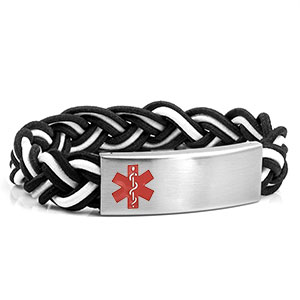
Click here for more information
Hope Paige makes only a small selection of medical alert bracelets, but their products shine when it comes to lightweight but durable materials that are nonmetallic.
Hope Paige makes braided and straight nylon straps for several of their medical alert bracelets, so if you aren’t enthusiastic about the all-metal designs from other manufacturers, Hope Paige is a good choice.
10. Divoti Medical Alert Bracelets
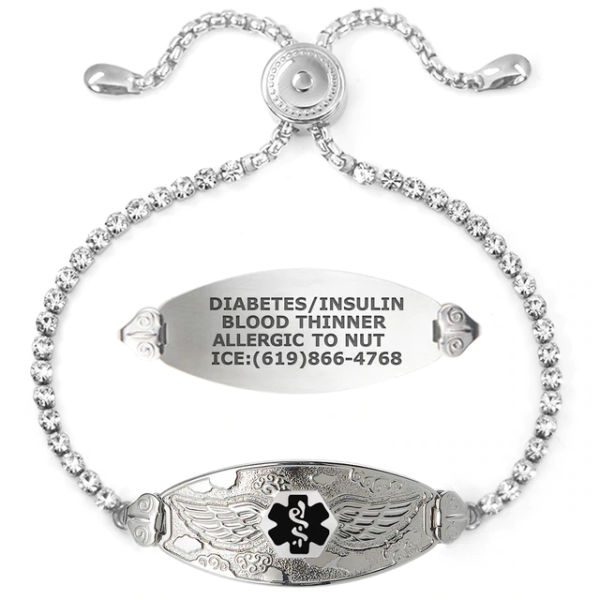
Click here for more information
Divoti makes simple but elegant medical alert bracelets with a distinctive style. They’re obviously recognizable as medical alert bracelets; the only downsides are that they don’t have quite the same range of options as other manufacturers, and don’t have quite as much space for text on the bracelets themselves.
Category winners
Best medical alert bracelet overall: Road iD
Simple, versatile, and highly customizable, Road iD is our favorite medical bracelet overall. You can take it anywhere, and it supports much more text than its competitors. On top of that, it’s designed to be sweat-proof and rain-proof, making it great for people who live active lives.
Best medical alert bracelet for kids: StickyJ Medical
Need a near-indestructible medical alert bracelet that won’t break the bank? StickyJ is the best choice, thanks to their many options for durable, kid-friendly medical alert bracelets.
Best medical alert bracelet for women: Lauren’s Hope
Women who want a more refined and elegant medical alert bracelet should look no further than Lauren’s Hope—their wide selection of jewelry-style medical alert bracelets means you don’t have to
Best medical alert bracelet for athletes: Road iD
Sweat, rain, pool water—all of these could corrode a cheap medical alert bracelet, but that’s not a worry with Road iD. The stainless steel construction and high-grade synthetic strapping makes Road iD the perfect choice for athletes of all kinds.
Best medical alert bracelet for older adults: Medic Alert
Medic Alert is great for older adults, because their medical alert bracelets are simple, obvious, and tarnish-resistant, thanks to their stainless steel construction.
Best metal medical alert bracelet: Lauren’s Hope
If you’re looking for a medical alert bracelet that’s both practical and aesthetically appealing, Lauren’s Hope should be your choice. They make the best all-metal medical alert bracelets on the market, all with excellent craftsmanship and a wide variety of designs to choose from.
Who should buy a medical alert bracelet?
Medical alert bracelets are meant to communicate critical information about your medical history or your current medications in the event you or someone you love is incapacitated or otherwise unable to communicate with a first responder.
They’re a very popular choice for people with allergies or diabetes, who can suffer an allergic reaction or insulin shock with little or no warning, and who require specific medical treatments in response.
Medical alert bracelets are also useful if a loved one has a condition like Down syndrome, autism, dementia, or Alzheimer’s, which make it difficult to fully communicate your full medical history, or which could lead to a loved one being lost or confused. Our team looked at a wide variety of providers to identify who makes the best medical alert bracelets.
How we ranked
To formulate our rankings of the top medical alert bracelets, we looked at a few key criteria. First, we looked for medical alert bracelets with ample text available for full disclosure of medical conditions.
Often, people who want medical alert bracelets have more than one important condition to disclose, or want to include an emergency contact as well as any necessary medical info.
We also carefully examined the materials used to construct the bracelet: high quality brands use hypoallergenic materials that are tough, strong, and also comfortable to wear. Lower quality medical alert bracelets may have nickel in them, which can irritate your skin, or may break easily—these medical alert bracelets didn’t make the cut.
In addition to construction quality, we took into consideration the aesthetic appeal. It’s hard to make objective rules for style, but brands that only offered large, clunky medical alert bracelets lost out to manufacturers that offered sleek, clean designs, or that offered a variety of styles to choose from. We kept in mind the fact that different types of users might want a different style of bracelet.
Someone who goes hiking may not want something heavy and metallic; while someone who wants to wear a medical alert bracelet for a night out on the town may want something that looks a little more high-end.
Finally, we kept an eye out for additional perks or unique features, like foldable medical info cards for people with lengthy medical histories.
After sorting the remaining brands by overall quality, we had our final rankings: these brands offer a variety of high-quality options ranging from casual and active to classy and formal.
Benefits
Medical alert bracelets provide critical information to first responders. Medical alert bracelets are durable pieces of jewelry worn around your wrist that can provide emergency medical responders and doctors with critical information about your medical history that could affect your care.
Medical alert bracelets are especially important for people who have medical conditions that could leave them unconscious or incapacitated, because they won’t be able to alert medical personnel to important information about their medical history.
We’ll go over some of the benefits and types of conditions that warrant wearing a medical alert bracelet.
People who have allergies to foods, insects, or commonly used medications can benefit from a medical alert bracelet. If you have severe allergies to bee stings, peanuts, penicillin, or another fairly common exposure that could result in a life-threatening allergic reaction, a medical alert bracelet can help a Good Samaritan or emergency first responder identify the problem and save your life.
It can be especially important. According to research published in the journal Pediatrics, a scientific publication marshaled by the American Association of Pediatricians, the prevalence of allergies to food is approximately 8% in the general population (1).
Among those who have food allergies, almost 40% of children have a history of severe adverse reaction to the food or foods they are allergic to, which would definitely be grounds for getting a medical alert bracelet. If you carry an epinephrine injector, or Epipen, it can be extremely useful to note on your bracelet.
That way, if you are incapacitated, a passerby or an emergency first responder can quickly try to find your Epipen and administer epinephrine.
Even if you don’t have your Epipen on you, first responders can have an epinephrine injection ready when they arrive.
If you put a warning about a medication allergy on your medical alert bracelet, you should talk to your doctor to make sure it’s accurate. Many people have allergies to common medications used in hospitals, such as penicillin, but research shows that many people who think they have a penicillin allergy are mistaken.
A study published in the Annals of Emergency Medicine by a team of doctors at at the University of Cincinnati Department of Emergency Medicine used immune reaction screening on a group of 150 patients admitted to the emergency department, all of whom reported having a penicillin allergy (2).
The results showed that 91% of the patients who claimed to have penicillin allergies, in fact, did not show an allergic reaction on a skin prick test.
This could have implications for healthcare, as some of the medications that are penicillin alternatives have additional adverse side effects, and even reporting a penicillin allergy—regardless of whether it is accurate or not—has been associated with increased length of hospital stays and increased rates of antibiotic-resistant infections.
That’s according to a study published in 2014 in the Journal of Allergy and Clinical Immunology (3).
These results indicate that it’s well worth your time to go see an allergy specialist to make sure the allergies you record on your medical alert bracelet are accurate before you get one.
Certain things, like your blood type or a “do not resuscitate” indicator, might not belong on a medical alert bracelet. Though it would seem logical to put critical information like your blood type or if you do not want to be resuscitated if you become incapacitated, practical and legal concerns prevent emergency responders from being able to trust the information on a medical alert bracelet when making a mistake could cost you your life.
If your blood type were incorrectly reported on your medical alert bracelet, for example, a transfusion of the wrong type of blood could kill you.
If you need to be administered blood, paramedics will usually just use universal blood to transfuse immediately, then use a blood typing kit to determine your blood type on the spot.
Similarly, since a medical bracelet does not carry the legal authorization of an advance healthcare directive (or “living will”), doctors might ignore bracelets or other personal attire that says “do not resuscitate,” due to their potential for being inaccurate, out of date, or not sufficiently detailed.
A widely discussed 2017 article in the New England Journal of Medicine discussed a case where an unconscious patient was admitted with a “do not resuscitate” tattoo (4). The tattoo caused more confusion than clarity; the physicians had to convene an emergency meeting of the ethics committee to decide whether to follow the tattoo’s instructions.
A much better solution is to have an advance healthcare directive on file, and wear a medical alert bracelet with your name and date of birth.
This way, doctors can rapidly and easily access your advance healthcare directive and confirm the precise details of your personal wishes.
Another piece of information that is very useful to include is the name and contact information of a loved one who can make medical decisions for you.
Medical alert bracelets for kids should be safe, inexpensive, and durable. Medical alert bracelets are very popular for certain conditions, but until relatively recently, their use has not been studied systematically. A 2011 study looked at the benefits of medical alert bracelets among a specific group of patients: children with hemophilia, a blood clotting disorder (X).
The study looked at a national sample of children who had hemophilia, and asked them and their caregivers about medical identification usage and preferences. One of the biggest takeaways from the study was that the biggest barrier for usage among younger children was fears of the bracelet being damaged, lost, or causing a safety or choking hazard.
Based on these findings, the report recommended that medical alert bracelet manufacturers develop bracelets specifically for children that are sized appropriately, tough and durable, not likely to present a choking hazard, and inexpensive to replace.
Many of the top brands have complied with these recommendations and offer several products that specifically address these concerns, so keep these guidelines in mind when looking for a medical alert bracelet for children.
Side effects
Medical alert bracelets are pretty easy and safe to use, though there are a few adverse effects to be aware of. Cheaper medical alert bracelets may use nickel in their metallic components, which can cause a contact allergy.
If you notice redness, itching, or irritation around your medical alert bracelet, especially around metal components, you might have a nickel allergy. If this is the case, opt for a higher-quality medical alert bracelet that uses hypoallergenic metals like surgical-grade stainless steel, or that avoid metal altogether.
Do make sure you wash (and dry) medical alert bracelets with warm, soapy water from time to time, since sweat, skin oils, and dead skin cells can accumulate on the bracelet and cause irritation or even mild fungal infections.
FAQ
Q: Are medical alert bracelets covered by insurance?
A: Like with medical alert systems and hearing aids, insurance coverage of medical alert bracelets and other forms of medical ID is spotty.
Sometimes, you can get reimbursed by a private insurer, especially if your doctor recommends one and submits the recommendation (as a “prescription”) to your insurance company.
Traditional medicare does not cover medical alert bracelets, though. You’ll have to talk to your insurance company to see if they’ll cover your medical alert bracelet if you have a private insurer.
On the bright side, medical alert bracelets are eligible expenses for a flexible spending account (FSA) or a health savings account (HSA), so feel free to credit your expenses to those accounts if you have one.
Q: Should you wear a medical alert bracelet for blood thinners?
A: Blood thinners like warfarin (and its name-brand equivalent, Coumadin) are one of the most popular medications to list on a medical alert bracelet.
Many doctors and pharmacists recommend putting it on your medical alert bracelet because these medications interact with a wide range of other prescription medications that you might be given as a part of typical medical treatment.
These blood thinners can also increase your risk of internal bleeding. In a car accident, for example, people on warfarin need to be examined more closely because they could have internal bleeding. You may also want to consider listing other medications with notably large interaction profiles, like MAOI inhibitors.
However, blood thinners are particularly good candidates for being listed on a medical alert bracelet because they tend to be prescribed for medical conditions that can suddenly incapacitate you, like cardiovascular disease.
Q: How does MedicAlert work?
A: MedicAlert is unique among medical alert bracelets in that they offer a service alongside their bracelet. Instead of an exhaustive list of medical conditions on the bracelet, a MedicAlert bracelet has an ID number on it and a phone number.
Medical personnel can call this number and receive detailed information about the wearer, including their name, medical history, and an emergency contact person.
MedicAlert is a good option if you have a lengthy medical history that could be relevant to your treatment, or if you have a loved one who could become lost or confused and need an emergency contact to get put in touch with.
Q: How can you get a stylish medical alert bracelet?
A: While style is somewhat subjective, we took aesthetics into consideration in formulating our rankings of the best medical alert bracelet companies on the market.
The top brands offer a range of styles, from sleek synthetic bands meant for sporting activities like running, cycling, and hiking, to subdued, classy designs made out of jewelry-quality metals.
The best way to get a classy medical alert bracelet is to shop around, take your time, and make sure you look carefully at the materials as well as the appearance. Look for solid metals instead of plated metal, and opt for hypoallergenic compounds when possible.
Q: Are all medical alert bracelets engravable?
A: Pretty much all medical alert bracelets can be engraved when you order them, save for a few low-cost options that are imprinted with just one non-customizable piece of information, like “diabetic.”
However, not all medical alert bracelets can be engraved again after being customized. This won’t matter to most people, though.
If things change and you need to add something to a medical alert bracelet, like a new medical condition or medication, you can just get a new bracelet: they aren’t so prohibitively expensive that it is worth it to add a new engraved line.
Q: What kind of people should wear a medical alert bracelet?
A: The best candidates for a medical alert bracelet are older adults, children, and people with dementia, Alzheimer’s, or mental disabilities: all of these kinds of people may not be able to tell first responders accurate information about their medical history.
Additionally, people who have a condition that could incapacitate them suddenly, like severe bee sting allergies, diabetes, or epilepsy, are also good candidates for a medical alert bracelet, since first responders are trained to look for medical alert bracelets when they come across someone who is unresponsive.
Q: How can you get a medical alert bracelet for free?
A: There are no general programs for everyone to get a medical alert bracelet for free, but a few organizations offer specific subsets of the population special access.
The Diabetes Research and Wellness Foundation has, at times, offered free medical alert bracelets for people with diabetes, and MedicAlert has offered free medical alert bracelets to children age 4 to 14, albeit only in Canada and only in areas sponsored by local Lions Clubs.
Q: What should you put on a medical alert bracelet?
A: The best things to put on a medical alert bracelet for you or for a loved one are medical conditions that could affect the quality of care you receive if you are unconscious. Allergies are a big one: if you become incapacitated because of a reaction to a bee sting, for example, or if you have a penicillin allergy, these would be good candidates for inclusion on a medical alert bracelet.
Other good candidates are conditions that make it hard or impossible for a loved one to alert first responders to their medical status, like Down syndrome, Alzheimer’s disease, dementia, or schizophrenia.
Also include medications that have broad, systemic effects like blood thinners (e.g. warfarin). Finally, it’s a good idea to put a name and an emergency contact on a medical alert bracelet if you or your loved one may not have identification on you.
Q: Are there medical conditions that are required to be put on a medical alert bracelet?
A: Technically, there are no medical conditions that are legally mandated to be on a medical alert bracelet—your private medical information, including what conditions you have, are protected by law.
However, there are some medical conditions that are very good ideas to disclose on a medical alert bracelet.
Generally, these are the sorts of conditions that could have consequences for your medical treatment, especially if you are unconscious or otherwise incapacitated.
Organizations like American Medical ID recommend putting allergies to common things like latex, bee stings, or penicillin, as well as medications like blood thinners. People with diabetes, a heart condition, epilepsy, or asthma should also consider disclosing these conditions on a medical alert bracelet.
Q: Are medical alert bracelets good for kids?
A: Medical alert bracelets are a great choice for kids who may have medical conditions they forget about or may not fully understand. Allergies, especially to stings or to certain medications, are good candidates, as are conditions like diabetes, which might affect the treatment your child needs.
A children’s medical alert bracelet should also have an emergency contact person and number. While emergency contact numbers are always a good idea, they’re especially important for kids, because they can’t consent to their own medical care.
Having a parent or guardian who can be contacted in an emergency to make decisions on medical care is of the utmost importance, so make sure any medical bracelet for kids has emergency contact info.
Kids will also benefit more from medical alert bracelets that are tough, inexpensive, and easy to care for: a high fashion rose gold bracelet is probably not the best choice! Opt for one of the many cost-effective bracelets that use silicone rubber or other synthetics instead.
Related articles
Recap
Medical alert bracelets can provide doctors, first responders, and Good Samaritans with critical information that can help save your life or improve the medical care you get if you become unconscious or incapacitated.
Things like allergies, important medications, and other critical health information can be very useful to include on a medical alert bracelet.
However, it’s important to make sure everything you put on your medical alert bracelet is accurate, as research shows that many people are mistaken when it comes to their medication allergies.
Finally, some things that you might think to put on your medical alert bracelet aren’t particularly helpful—your blood type, for example, is much more easily and safely determined by paramedics from a blood typing kit, and the words “do not resuscitate,” by themselves, might not be honored.
If you have an advance healthcare directive, you can indicate this, but you should provide your full name and date of birth on your medical alert bracelet, plus contact information for a loved one. That way, the precise details of your advance medical directive can be followed with no ambiguity.
Once you know what to put on your medical alert bracelet and what to leave off, it’s a lot easier to understand how they can help improve the medical care you get if you are unconscious or incapacitated.
For BodyNutrition‘s #1 medical alert bracelet recommendation, click here.